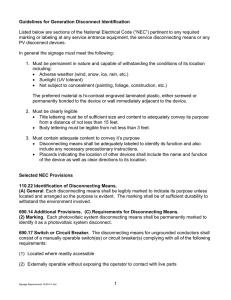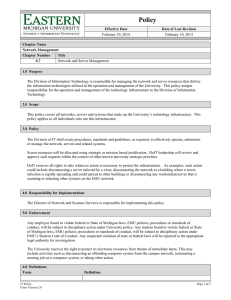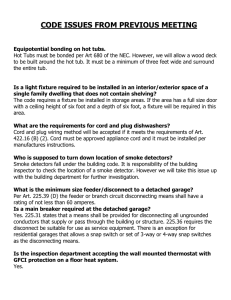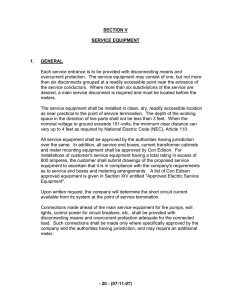Bulletin 50-1-2 - Electrical Safety Authority
advertisement
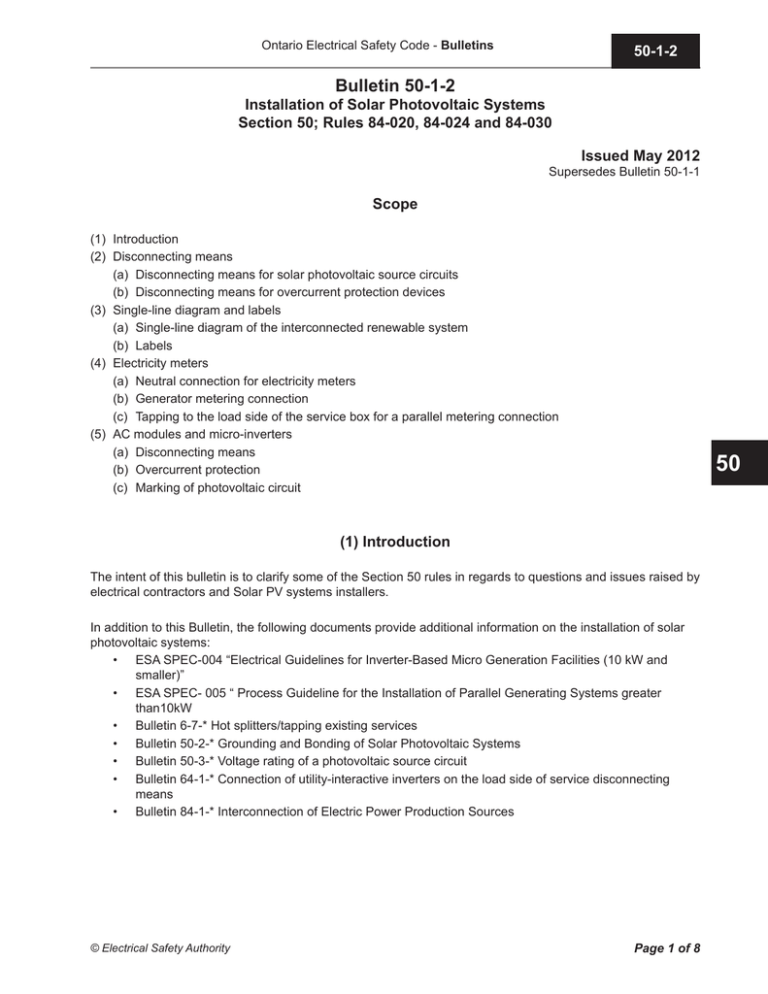
Ontario Electrical Safety Code - Bulletins 50-1-2 Bulletin 50-1-2 Installation of Solar Photovoltaic Systems Section 50; Rules 84-020, 84-024 and 84-030 Issued May 2012 Supersedes Bulletin 50-1-1 Scope (1)Introduction (2) Disconnecting means (a) Disconnecting means for solar photovoltaic source circuits (b) Disconnecting means for overcurrent protection devices (3) Single-line diagram and labels (a) Single-line diagram of the interconnected renewable system (b)Labels (4) Electricity meters (a) Neutral connection for electricity meters (b) Generator metering connection (c) Tapping to the load side of the service box for a parallel metering connection (5) AC modules and micro-inverters (a) Disconnecting means (b) Overcurrent protection (c) Marking of photovoltaic circuit 50 (1) Introduction The intent of this bulletin is to clarify some of the Section 50 rules in regards to questions and issues raised by electrical contractors and Solar PV systems installers. In addition to this Bulletin, the following documents provide additional information on the installation of solar photovoltaic systems: • ESA SPEC-004 “Electrical Guidelines for Inverter-Based Micro Generation Facilities (10 kW and smaller)” • ESA SPEC- 005 “ Process Guideline for the Installation of Parallel Generating Systems greater than10kW • Bulletin 6-7-* Hot splitters/tapping existing services • Bulletin 50-2-* Grounding and Bonding of Solar Photovoltaic Systems • Bulletin 50-3-* Voltage rating of a photovoltaic source circuit • Bulletin 64-1-* Connection of utility-interactive inverters on the load side of service disconnecting means • Bulletin 84-1-* Interconnection of Electric Power Production Sources © Electrical Safety Authority Page 1 of 8 50-1-2 Ontario Electrical Safety Code - Bulletins (2) Disconnecting means (a) Disconnecting means for solar photovoltaic source circuits Question 1 Does Rule 50-016(1) require disconnecting means for each photovoltaic source circuit (panel or modules connected in series)? Answer 1 No. Having said that, Rule 50-016(3) requires means to disable and isolate PV output circuits greater than 50 V. According to Appendix B note, an opaque covering is an acceptable means of disabling the array. Servicing the equipment on the photovoltaic side of disconnecting means, such as overcurrent devices or modules, may require disabling all or portions of the array since PV modules or panels are always energized when exposed to any light source. (b) Disconnecting means for overcurrent protection devices Question 2 Does the Code require disconnecting means for overcurrent devices that may be required by Rule 50-012? Answer 2 Based on Section 14 and depending on the type of overcurrent protection used, the disconnecting means may or may not be required. It should be also noted that disconnecting means may not be rated as load break devices and should not be operated without first disabling the current source. See Diagram B1: • Fuses (in non finger safe fuse holders): Disconnecting means is required • Circuit breakers: Disconnecting means is not required • Finger-safe fuse holders & fuses OR Supplementary protectors: Disconnecting means is not required* (*) Note: Not rated to be opened under load. Page 2 of 8 © Electrical Safety Authority Ontario Electrical Safety Code - Bulletins 50-1-2 Diagram B1 – Requirements for disconnecting means 50 Question 3 Where disconnecting means is required for fuse holders and fuses (not designed to be finger safe), and is not integral with the combiner box in which fuses are located, what is meant by “adjacent to” for these types of installations? Answer 3 If the disconnecting means is not an integral part with the fuses, then it shall be installed within sight and within 9 m from the fuse holder. A warning sign is required to indicate that all switches must be opened to de-energize from all sources before replacing fuses. (3) Single-line diagram and labels (a) Single-line diagram of the interconnected renewable system Question 4 Does Diagram B2 meet the requirements of Rule 84-030(2) for the single-line diagram of the interconnected system that is located at the supply authority disconnect switch? © Electrical Safety Authority Page 3 of 8 50-1-2 Ontario Electrical Safety Code - Bulletins Diagram B2 – Typical single-line diagram of the interconnected system with parallel meter connection Answer 4 Yes, this meets the minimum single-line diagram requirements of Rule 84-030(2). Note The system ratings required by Rule 50-004 are not required to be displayed at the supply authority disconnect or on the single-line diagram. The label required by Rule 50-004 shall be posted at the generator (Source) disconnecting means. (b) Labels Question 5 What Codes or Standards provide requirements for labels, e.g. “DG SOURCE DISCONNECT”, “UTILITYINTERCONNECTED”, “DG SYSTEM DISCONNECT – WARNING – TWO POWER SOURCES”? Does the code require specific wording? Answer 5 Rules 2-100 and 84-024 require the labels. However, the rules do not specify the specific wording. The wording provided in ESA SPEC-004 can be used as an example. The following markings are applicable CSA Part 2 standards requirements and can be used as guidance: • CSA Standard C22.2 No. 257 defines “Distributed generation (DG)” as an electric generation facilities connected to a distribution system through the point of common coupling. In Annex B of Standard C22.2 No. 257 that is informative shows similar labels as in ESA SPEC-004, i.e. “DG - source disconnect means”. • CSA Standard C22.2 No. 107.1, Clause 15.4.1.1 requires “When the unit complies with Clause 15, it shall be marked: UTILITY - INTERCONNECTED, or the equivalent”, and Clause 15.4.1.3 specifies: “A utilityinterconnected inverter shall be marked: WARNING - POWER FED FROM MORE THAN ONE SOURCE, or the equivalent.” Page 4 of 8 © Electrical Safety Authority Ontario Electrical Safety Code - Bulletins 50-1-2 Question 6 What is considered acceptable for exterior, weatherproof labels required by Section 84? Does the Code specify letter size? Answer 6 The Code does not provide specific requirements; the labels need to be able to withstand the elements, be permanent and legible, for example: lamacoid, engraved metal plate, or equivalent. Additionally, the label has to satisfy the local supply authority requirements. (4) Electricity meters (a) Neutral connection for electricity meters Question 7 For a parallel metering connection, where the generation meter is on the supply side of the service disconnecting means, do all 4-jaw revenue meters require a neutral conductor to be terminated in the meter base? Answer 7 No. According to Rule 10-624(4), the grounded conductor on the supply side of the service disconnecting means is permitted to be used as a bonding conductor for the revenue meter device. In this case the grounded conductor is required to be bonded to the meter mounting device. However, when the grounded conductor is not used as a bonding conductor for the revenue meter device, the grounded conductor can be run through the meter base without being terminated and a separate bonding conductor shall be provided between the service and the meter. (b) Generator metering connection Direction 1 The requirement in the ESA SPEC-004 is to always have the Line side of the metering cabinet connected to the utility and the Load side connected to the customer, to ensure consistency and safety, as per Diagram B3. Diagram B3 – Generation meter connection Rationale When pulling a meter, the standard practice is that the Load side of the metering cabinet will be de-energized and caution is taken around the Line side as it may be energized. The ESA guideline is consistent with the Ontario Power Authority’s (OPA’s) “microFIT Contract” which requires bi-directional metering for the generator facility. © Electrical Safety Authority Page 5 of 8 50 50-1-2 Ontario Electrical Safety Code - Bulletins (c) Tapping to the load side of the service box for a parallel metering connection Question 8 In installations where the existing customer load meter is downstream of the main service disconnect, does the code permit tapping to the load side lugs of the service disconnect for a FIT or microFIT installation with a parallel metering configuration, as per Diagram B4? Diagram B4 – Tapping to the to the load side lugs of the service disconnect Answer 8 Yes; According to Bulletin 6-7-*, a maximum of one tap is permitted per service box. Therefore, the generator meter in a parallel configuration is allowed to be connected to the load side lugs of service disconnect and be terminated in accordance with Bulletin 6-7-*. (5) ac modules and micro-inverters Rule 50-002 defines ac module as “a complete, environmentally protected assembly of interconnected solar cells, inverter, and other components designed to generate ac power.” ac modules are designed to generate ac power when exposed to sunlight and do not have accessible, field installed dc wiring (as shown in the Photo B1). (a) Disconnecting means For ac modules where the inverter is an integral part of the generator (as shown on Photo B1), and the combined unit is approved, there is no requirement for a disconnecting means of the integral inverter. However, if any other electric power production source is interconnected with an ac module, the disconnecting means in accordance with Rule 84-020 is required for all production sources. Page 6 of 8 © Electrical Safety Authority Ontario Electrical Safety Code - Bulletins 50-1-2 Photo B1 – ac module where the inverter is an integral part of the generator For Micro-inverters, inverters plugged into the photovoltaic panels (as shown in Photo B2), no additional disconnect switch is required. Photo B2 –Micro-inverter 50 (b) Overcurrent protection The output circuits of ac modules shall have overcurrent protection according to Rule 50-012 requirements. (c) Marking of photovoltaic circuit Question 9 Does the OESC require marking of a PV system with ac modules when interconnecting to the supply authority? Answer 9 Yes. Although requirements of Rule 50-004 for marking of the photovoltaic output circuit at the generator disconnecting means are not applicable to ac modules, according to Rule 2-100, PV installations utilizing ac modules connected to the supply authority shall be marked to identify the PV system rating and suitability for the particular installation. Question 10 What is the required marking for a PV system with ac modules? © Electrical Safety Authority Page 7 of 8 50-1-2 Ontario Electrical Safety Code - Bulletins Answer 10 According to Rule 2-100 and the intent of Rule 50-004, the required marking for PV installations utilizing ac modules connected to the supply authority are: • rated ac output current • nominal operating ac voltage Question 11 Where is the marking for a PV system with ac modules required to be located? Answer 11 The required marking for PV installations utilizing ac modules connected to the supply authority shall be located at the supply authority disconnect; or be included in the single-line diagram required by Rule 84-030(2). Page 8 of 8 © Electrical Safety Authority
